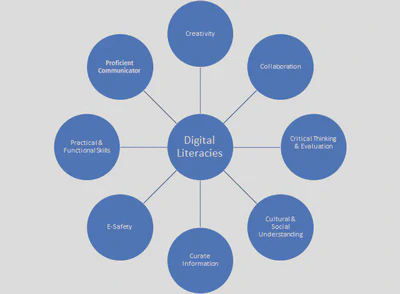Google the term “digital literacy and the workplace” and you will be overwhelmed with the results. A good place to start might be the Adobe blog article How Digital Literacy Affects the Modern Workforce.
A tweet by Helen Blunden pointed me at the work of Tracy Van Der Schyff, including this post on Digital literacy and the impact on user adoption. The model Tracey uses in that post looked slightly familiar, and after a bit of digging I think I have managed to place it as emerging from work done in the early part of the 2010’s by JISC, leading a substantial amount of research around the modern digital literacies needed by learners.
Although the original work was around the needs of learners (of all ages) in education, I think it’s reasonable to extrapolate to the needs of people working in a wide range of jobs that handle information and knowledge in some form.
Tracey’s presentation is written specifically from the perspective of encouraging users to make good use of a set of specific digital tools (in her case the Microsoft Office 365 suite) but I think the model is more general than that.
Capturing here for future reference,

Looking for definitions, I found and adapted from Payton and Hague 2010, giving us:
| Creativity | The ability to think creatively and imaginatively, and to use technology to create outputs and represent knowledge in different formats and modes. Knowing when and how digital technology can support creative processes, and thinking creatively about technology and with technology. |
| Collaboration | The ability to work successfully with others to collaboratively create and share meaning and understanding. To develop the skills of team work, to be able to work together when using technology and to understand how technology can support collaboration. |
| Critical Thinking and Evaluation | Being able to use reasoning skills to engage with digital media and its content,to question, analyse, scrutinise and evaluate it and to formulate and support arguments about it and the way it is used. Critical thinking involves being reflective, developing insight about underlying assumptions, interpreting meaning and determining significance in order to understand and make sense of the world. |
| Cultural and Social Understanding | The ability to recognise that there are social, cultural and historical influences that shape the creation of digital content and our understanding of it. This involves understanding how your own and others’ perspectives have been informed by cultural heritages and being aware of the social and cultural contexts in which digital media is created and used. |
| Curate Information | To define what sort of information you need for a task or activity, to know where and how to find information, to critically engage with sources to select relevant, valuable and reliable information and to be aware of intellectual property issues related to plagiarism and copyright. |
| E-Safety | The ability to stay safe when using digital technologies, and to understand what constitutes appropriate use and appropriate content |
| Practical & Functional Skills | Knowing how to use a range of different technologies competently and having the skills and flexibility to adapt this knowledge to learn how to use new technologies |
| Proficient Communicator | Being able to clearly express ideas so that others can understand them. Having an understanding of the different modes in which meaning can be represented and showing an awareness of the needs of particular audiences. Understanding how technology can support this and how to communicate effectively using different types of technology. |